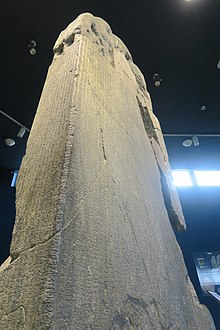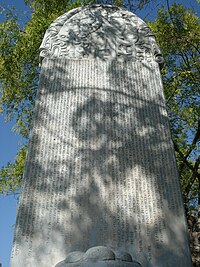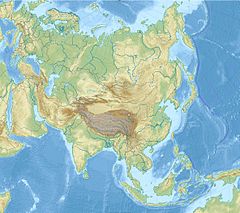| Orkhon inscriptions | |
|---|---|
| simplified Chinese: 阙特勤碑; traditional Chinese: 闕特勤碑; pinyin: Què tèqín bēi | |
 Kul Tigin Monument of Orkhon Inscriptions – Orkhon Museum, Kharkhorin, Mongolia Kul Tigin Monument of Orkhon Inscriptions – Orkhon Museum, Kharkhorin, Mongolia | |
| Type | Memorial |
| Height | 3.3 metres (11 ft) |
| Width | 1.3 metres (4 ft 3 in) |
| Symbols | Old Turkic script |
| Created | 8th century |
| Discovered | 1889 Orkhon Valley, Mongolia 47°33′38″N 102°50′28″E / 47.56056°N 102.84111°E / 47.56056; 102.84111 |
| Discovered by | Nikolay Yadrintsev |
| Present location | Bilge Khan and General Kul Tigin Complex |
The Orkhon inscriptions (also known as the Orhon inscriptions, Orhun inscriptions, Khöshöö Tsaidam monuments (also spelled Khoshoo Tsaidam, Koshu-Tsaidam or Höshöö Caidam), or Kul Tigin steles (simplified Chinese: 阙特勤碑; traditional Chinese: 闕特勤碑; pinyin: Què tèqín bēi)) are two memorial installations erected by the Göktürks written in the Old Turkic alphabet in the early 8th century in the Orkhon Valley in what is modern-day Mongolia. They were erected in honor of two Turkic princes, Kul Tigin and his brother Bilge Khagan.
The inscriptions, in both Chinese and Old Turkic, relate the legendary origins of the Turks, the golden age of their history, their subjugation by the Tang dynasty, and their liberation by Ilterish Qaghan. According to one source, the inscriptions contain "rhythmic and parallelistic passages" which resemble that of epics.
Discovery and translation

The inscriptions were discovered by Nikolay Yadrintsev's expedition in 1889, published by Vasily Radlov. The original text was written in the Old Turkic alphabet and was deciphered by the Danish philologist Vilhelm Thomsen in 1893. Vilhelm Thomsen first published the translation in French in 1899. He then published another interpretation in Danish in 1922 with a more complete translation.
Region
Orkhon Valley is a region on the western Orkhon River in modern-day Mongolia, near Ögii Lake. More specifically, they stand about fifty miles north of the Erdene Zuu Monastery, and approximately twenty-five miles northwest of the Ordu-Baliq.
Importance
Before the Orkhon Inscriptions were deciphered by Vilhelm Thomsen, very little was known about Turkic script. The scripts are the oldest form of a Turkic language to be preserved. When the Orkhon inscriptions were first discovered, it was obvious that they were a runic type of script that had been discovered at other sites, but these versions also had a clear form, similar to an alphabet. When Vilhelm Thomsen deciphered the translation it was a huge stepping stone in understanding old Turkic script. The inscriptions provided much of the foundation for translating other Turkic writings.
The scripts follow an alphabetical form, but also appear to have strong influences of rune carvings. The inscriptions are a great example of early signs of nomadic society's transitions from use of runes to a uniform alphabet, and the Orkhon alphabet is thought to have been derived from or inspired by a non-cursive version of the Sogdian script.
Restoration
Both inscriptions are part of the Orkhon Valley Cultural Landscape UNESCO World Heritage Site in Mongolia. TIKA (Turkish International Cooperation and Development Agency) showed interest in the site in the late 20th century and finalized their project to restore and protect all three inscriptions. Since 2000, over 70 archeologists from around the world (specifically from Uighur, Turkmenistan, Azerbaijan, Uzbekistan, Tataristan and Turkey) have studied the area and performed excavations. The site is now protected by fences with buildings for research work and storage of artifacts. The total cost of the project is around 20 million dollars and eventually will include the building of a museum to house the inscriptions and other recently discovered artifacts.
Historical context
They were erected by the Göktürks in the early 8th century. They commemorate the brothers Bilge Khagan (683–734) and Kul-Tegin (684–731), one a politician and the other a military commander. Both were descendants of Ilterish Qaghan of the Second Turkic Khaganate, which was a prominent Turkic nomadic society during the Tang dynasty.

The Göktürks have left artifacts and installations all over their domain, from Manchuria to the Black Sea. But only in modern-day Mongolia have any memorials to kings and other aristocrats been found. The ones in Khöshöö Tsaidam consist of tablets with inscriptions in Chinese and Old Turkic characters. Both monuments are stone slabs originally erected on carved stone turtles within walled enclosures. Bilge Khagan's stone shows a carved ibex (the emblem of Göktürk Kagans) and a twisted dragon. In both enclosing's, evidence of altars and carved depictions of human couples were found, possibly depicting the respective honorary and his spouse.
The Old Turkic inscriptions on these monuments were written by Yollug Tigin who was nephew of Bilge Khagan. These inscriptions together with the Tonyukuk inscription, are the oldest extant attestation of that language. The inscriptions clearly show the sacred importance of the region, as evidenced by the statement, "If you stay in the land of the Ötüken, and send caravans from there, you will have no trouble. If you stay at the Ötüken Mountains, you will live forever dominating the tribes!".
Content of the inscriptions

A full English translation of the inscriptions may be found in The Orkhon Inscriptions: Being a Translation of Professor Vilhelm Thomsen's Final Danish Rendering
The two monuments themselves have engravings on all four sides. However, some of the script was not preserved, or is missing, and therefore only portions of the original message remain. What follows is a summary of the most complete section of the inscriptions. One translation of the first and second monuments seems to indicate that the text continues from one side to the other.
The first portion of the Turkic translations seems to be Bilge Khagan discussing the commemoration of the tablet, as well as mentioning the extent of the empire. One passage reads,
"To the East I have made campaigns as far as the Shantung plain, and almost reached the sea; to the South I have made campaigns as far as Tokuz-Ersin and almost reached Tibet; to the West I have made campaigns beyond Yenchii-Iigiiz (Pearl River) as far as Timir-Kapig (The Iron Gate); to the North I have made campaigns as far as the land of the Yer-Bayirku's. To all these lands have I led (the Turks). The forest of Mount Otiikin has no overlord; the forest of Mount Otiikin is the place where the kingdom is held together."
The inscriptions also highlight Bilge Khagan's accomplishment of uniting his people. As one passage reads,
"By the will of Heaven, and because I was greatly deserving and it so brought it about, I brought the dying people back to life; for the naked people I found clothing, the poor people I made rich, the scanty people I made numerous. I have made the other, which has a kingdom and a kagan, to stand higher. All the peoples in the four quarters of the world I have brought to keeping the peace and making an end of hostilities; they all have obeyed me, and serve me."
The rest of the inscriptions are broken up and sporadic, but seem to detail the conquests against the Kirghiz and the Tangut peoples and also the death of Kul-Tegin in battle, and eventually the succession of Bilge Khagan by his son. Bilge Khagan's mother El Bilga Khatun was also mentioned in these inscriptions.
The following is an excerpt from the last paragraph of the inscriptions (in Old Turkic and English languages):

Relations with the Chinese
Main article: Turks in the Tang militaryThe inscriptions seem to have mixed views on Tang Chinese influence. On the one hand, it seems to contain the view that the Turks despise the Chinese. It appears as though Bilge Khagan wanted to distinguish his people from the Chinese in order to remain a strong independent society. In the inscription Bilge Khagan reprimands those Turks who have been influenced by Chinese culture and have adopted a Chinese way of life. As one passage reads,
"Because of want of harmony between the begs and the people, and because of the Chinese people's cunning and craft and its intrigues, and because the younger and the elder brothers chose to take counsel against one another and bring discord between begs and people, they brought the old realm of the Turkic people to dissolution, and brought destruction on its lawful kagans. The sons of the nobles became the bondsmen of the Chinese people, their unsullied daughters became its slaves. The Turkic begs gave up their Turkic names, and bearing the Chinese names of Chinese begs they obeyed the Chinese Emperor, and served him during fifty years. For him they waged war in the East towards the sun's rising, as far as Bokli kagan, in the West they made expeditions as far as Taimirkapig; for the Chinese Emperor they conquered kingdoms and power. The whole of the common Turkic people said thus: 'I have been a nation that had its own kingdom; where is now my kingdom? For whom do I win the kingdoms? said they. I have been a people that had its own kagan; where is my kagan? Which kagan is it I serve?'".
The claimed enslavement of the Turks also did not help the reputation of the Chinese. Bilge Khagan seems to blame the Chinese for the disunion of his Turkic state. This Turkic view of the Chinese seems to be negative.
Orkhon inscriptions indicate prisoners of war have often designated the status of slavery. Inscriptions found in the First Turkic Khaganate also imply that terms denoting slavery or other forms of subordinate status, such as qul (male slave) and küng (female slave or handmaiden), are frequently applied to a population of defeated political entities.
However, the translation also reveals a degree of diplomacy with the neighboring Chinese, as evidenced by his statement,
"While I have ruled here, I have become reconciled with the Chinese people. The Chinese people, who give in abundance gold, silver, millet, and silk, have always used ingratiating words and have at their disposal enervating riches. While ensnaring them with their ingratiating talk and enervating riches, they have drawn the far-dwelling peoples nearer to themselves. But after settling down near them these we have come to see their cunning."
Bilge Khagan also references the hiring of Chinese artists when he claims,
"From the Chinese Emperor I have had artists to come, and have set them to work. My request has not been refused. They have sent the Chinese Emperor's court painters. I have bidden them set up a separate hall, and inside and out I have had them to make various paintings. I have had the stone hewn; that which lay in my heart to utter I have. Understand to see this all as far as the suns and subjects of the Ten Arrows. I have had the memorial stone hewn."
To further complicate the already muddled view of the Chinese, the inscriptions contain both Turkic and Chinese translations. Thus, the inscription contains evidence that Bilge Khagan had cultural interaction with the Tang dynasty.
See also
References
Citations
- ^ Ross, E. Denison (1930). "The Orkhon Inscriptions: Being a Translation of Professor Vilhelm Thomsen's Final Danish Rendering". Bulletin of the School of Oriental Studies, University of London. 5 (4): 861–76. doi:10.1017/S0041977X00090558. JSTOR 607024. S2CID 140199091.
- Krueger, John R. (1962). "The Earliest Turkic Poem". Journal of the American Oriental Society. 82 (4): 557. doi:10.2307/597528. JSTOR 597528.
- "Orhon inscriptions". Encyclopædia Britannica. Retrieved November 10, 2010.
- Kempf, Bela. "Old Turkic runiform inscriptions" (PDF). Turkic Languages. 8: 41–52.
- "Orkhon/Old Turkic". Omniglot.
- "Orkhon inscriptions placed under protection". Hurriyet Daily News.
- Golden, Peter B. (2010). Turks and Khazars : origins, institutions, and interactions in pre-Mongol Eurasia. Farnham, England: Ashgate/Variorum. ISBN 978-1-4094-0003-5.
- Sinor, Denis (2002). "Old Turkic". History of Civilizations of Central Asia. 4. Paris: UNESCO Publishing. pp. 331–333. ISBN 978-0-7007-0869-7.
- Tekin, Talat (1997). A Grammar of Orkhon Turkic (Uralic and Altaic). Routledge. ISBN 978-0-7007-0869-7.
- Tekin, Talat (1995). Les Inscriptions des L'Orkhon. Istanbul: Simurg. ISBN 978-975-7172-06-2.
- Drompp, Michael R. (1999). "Breaking the Orkhon Tradition: Kirghiz Adherence to the Yenisei Region after A. D. 840". Journal of the American Oriental Society. 119 (3): 390–403. doi:10.2307/605932. JSTOR 605932.
- Pohl, Walter (15 December 2018). The Avars: A Steppe Empire in Central Europe, 567–822. Cornell University Press. p. 257. ISBN 978-1-5017-2940-9.
- Sela, Ron; Cameron Levi, Scott, eds. (2010). Islamic Central Asia An Anthology of Historical Sources. Indiana University Press. p. 55.
- Kemal Silay (1996). An Anthology of Turkish Literature. The University. pp. 4, 5. ISBN 978-1-878318-11-4.
- J. J. Saunders (1 March 2001). The History of the Mongol Conquests. University of Pennsylvania Press. pp. 24–. ISBN 978-0-8122-1766-7.
- René Grousset (1953). The Rise and Splendour of the Chinese Empire. University of California Press. pp. 130–. ISBN 978-0-520-00525-9.
- Julia Lovell (1 December 2007). The Great Wall: China Against the World, 1000 BC - AD 2000. Grove/Atlantic, Incorporated. pp. 142–. ISBN 978-1-55584-832-3.
- Analecta Orientalia Posthumous Writings and Selected Minor Workds. Brill Archive. pp. 42–. GGKEY:3S3JPXD29QD.
- Luther Carrington Goodrich (2002). A Short History of the Chinese People. Courier Corporation. pp. 120–. ISBN 978-0-486-42488-0.
- Edward H. Schafer (1963). The Golden Peaches of Samarkand: A Study of Tʻang Exotics. University of California Press. pp. 49–. ISBN 978-0-520-05462-2.
- Denis C. Twitchett (27 September 1979). The Cambridge History of China: Volume 3, Sui and T'ang China, 589-906 AD, Part One. Cambridge University Press. pp. 223–. ISBN 978-0-521-21446-9.
- ^ Scharlipp, Wolfgang-Ekkehard (1995). "China and Tibet as Referred to in the Old Turkic Inscriptions". Diogenes. 43: 45–42.
- Golden, "Terminology," p. 29.
Sources
- Report of the 28th Session of the World Heritage Committee
- Sören Stark Die Alttürkenzeit in Mittel- und Zentralasien. Archäologische und historische Studien (Nomaden und Seshafte, Band 6). Reichert: Wiesbanden 2008, pp. 76–78, plates 5-7.
External links
| Göktürks | |
|---|---|
| First Turkic Khaganate (552–581) |
|
| Eastern Turkic Khaganate (581–630) | |
| Western Turkic Khaganate (581–657) | |
| Second Turkic Khaganate (682–744) | |
| Western Turks under Jimi system |
|
| Göktürk culture | |
| Göktürk wars and battles | |
| Titles | |
| Family | |
| Turkic inscriptions | |||||||||
|---|---|---|---|---|---|---|---|---|---|
| Oghur Turkic |
| ||||||||
| Siberian Turkic |
| ||||||||
| Karluk Turkic |
| ||||||||
| Non-Turkic |
| ||||||||
| Presumably Turkic | |||||||||